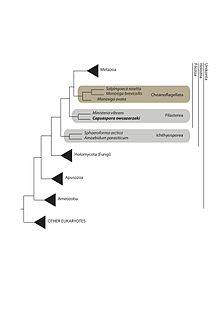Capsaspora
| Capsaspora | |
|---|---|

| |
| Scientific classification | |
| Domain: | Eukaryota |
| Class: | Filasterea |
| Order: | Ministeriida
|
| Family: | Capsasporidae Cavalier-Smith, 2008[2] |
| Genus: | Capsaspora Hertel, Bayne & Loker 2002[1] |
| Species: | C. owczarzaki
|
| Binomial name | |
| Capsaspora owczarzaki Hertel, Bayne & Loker 2002
| |
Capsaspora is a
Description
C. owczarzaki was originally described as an amoeba-like “symbiont” of the fresh-water snail
C. owczarzaki’s life cycle comprises 3 different stages with three different cell types, which was reported only recently.[when?] Under culture conditions, C. owczarzaki’s filopodial cells crawl attached to the substrate, with active replication until the end of the exponential growth phase. Then, cells start to detach, retracting the branching filopodia and encysting. During this cystic phase, division is stopped. Alternatively, amoebae can actively aggregate to each other by unknown factors, forming a multicellular, aggregative structure and secreting an unstructured extracellular material that seems to prevent direct cell-cell contact.
C. owczarzaki cells, in the filopodial stage, were described as 3 to 5 μm amoebas with a nucleus ⅓ - ½ of the diameter of the cell (containing a central nucleolus), long branched filopodia, mitochondria with flattened cristae, numerous phagosomes, lipid vacuoles, glycogen granules and a Golgi apparatus.[6][7] Cystic cells measure 4 to 5 μm with a double wall: the outer thin, irregular and loosely attached; and the inner thicker, smooth.[8]
Taxonomy
C. owczarzaki is together with 
Applications
C. owczarzaki is of scientific interest because it is one of the closest unicellular relatives of multicellular animals. Its genome has recently been sequenced and shows several genes involved in
References
- PMID 12117501
- ^ PMID 18461162.
- PMID 23942320.
- PMID 27114036.
- PMID 27746046.
- ^ PMID 501126.
- ^ PMID 7365267.
- ^ Sebe-Pedros, A. (2013) The origin of metazoan multicellularity, a genomic and functionalapproach. PhD UB, Facultat de Biologia, Departament de Genètica
- ^ PMID 21771718.
- PMID 23083534.
- PMID 12117501.
- S2CID 44548329.
- ISSN 1475-3006.
- PMID 15556849.
- S2CID 24862220.
- PMID 18184723.
- ^ PMID 18461162.
- PMID 21771718.
- PMID 26365255.
- PMID 20479219.
- PMID 21087945.
- S2CID 27205070.
- PMID 7365267.
